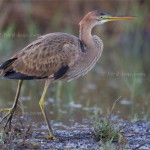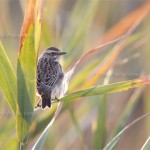 Spectacular numbers of Pallid Harrier, Circus macrourus, and Red-footed Falcon, Falco vespertinus, were the highlight of the first day. Having spent 3 days in May north of Constanta at Romania´s Black Sea coast, it was decided to try our luck with birds again in the area around the village of Vadu. The target was, to increase the birdlist and to look what differences in the bird diversity we could experience. South of the Danube Delta is wide stretch of a sandy shoreline with shallow lagoons. This is part of Romania´s Black Sea coast. September– like May – is migration time. Whereas the association of the east Romanian countryside is normally with the core Danube Delta with its special birds like Pelicans, Black-necked and Red-necked Grebes, Glossy Ibises, Spoonbills, the stretch of coast just south of the Danube Delta up to the northern city limits of Constanta is an excellent birding spot not only for migrating birds, too. Two dedicated bird photographers went for the countryside area near of Vadu at the sandy coast in the 3rd week of September 2012. The area called Dobrudja with its steppe habitat more to the west was neglected this time. All breeding specialities should have gone already.
Spectacular numbers of Pallid Harrier, Circus macrourus, and Red-footed Falcon, Falco vespertinus, were the highlight of the first day. Having spent 3 days in May north of Constanta at Romania´s Black Sea coast, it was decided to try our luck with birds again in the area around the village of Vadu. The target was, to increase the birdlist and to look what differences in the bird diversity we could experience. South of the Danube Delta is wide stretch of a sandy shoreline with shallow lagoons. This is part of Romania´s Black Sea coast. September– like May – is migration time. Whereas the association of the east Romanian countryside is normally with the core Danube Delta with its special birds like Pelicans, Black-necked and Red-necked Grebes, Glossy Ibises, Spoonbills, the stretch of coast just south of the Danube Delta up to the northern city limits of Constanta is an excellent birding spot not only for migrating birds, too. Two dedicated bird photographers went for the countryside area near of Vadu at the sandy coast in the 3rd week of September 2012. The area called Dobrudja with its steppe habitat more to the west was neglected this time. All breeding specialities should have gone already.
The trip date was perfect, allowing us to see good variety of species, many of them in considerable numbers, especially raptors. We also saw waders, gulls, herons, pelicans and passerines.
The Bird Diversity we enjoyed was high; exactly 90 species of birds we found in only 2,5 days. Highlights of the tour you will find in the gallery. Among others we made photos of Black-necked Grebe, Podiceps nigricollis, Dalmatian Pelican, Pelecanus crispus, Purple Heron, Ardea purpurea,  Ruddy Shelduck, Tadorna ferruginea, Common Shelduck, Tadorna tadorna, Black Kite, Milvus migrans, Western Marsh-Harrier, Circus aeruginosus, Pallid Harrier, Circus macrourus, Montagu’s Harrier, Circus pygargus, Eurasian Sparrowhawk, Accipiter nisus, Red-footed Falcon, Falco vespertinus, Eurasian Hobby, Falco subbuteo, Peregrine Falcon, Falco peregrinus, Common Quail, Coturnix coturnix, Syrian Woodpecker, Dendrocopos syriacus, Red-backed Shrike, Lanius collurio, Sedge Warbler, Acrocephalus schoenobaenus, many Willow Warblers, Phylloscopus trochilus, Common Chiffchaff, Phylloscopus collybita, lots of Blackcaps, Sylvia atricapilla, only a few Common Whitethroats, Sylvia communis, many Lesser Whitethroats, Sylvia curruca, many Spotted Flycatchers, Muscicapa striata and Red-breasted Flycatchers, Ficedula parva, good numbers of Common Redstarts, Phoenicurus phoenicurus, Whinchats, Saxicola rubetra,
Ruddy Shelduck, Tadorna ferruginea, Common Shelduck, Tadorna tadorna, Black Kite, Milvus migrans, Western Marsh-Harrier, Circus aeruginosus, Pallid Harrier, Circus macrourus, Montagu’s Harrier, Circus pygargus, Eurasian Sparrowhawk, Accipiter nisus, Red-footed Falcon, Falco vespertinus, Eurasian Hobby, Falco subbuteo, Peregrine Falcon, Falco peregrinus, Common Quail, Coturnix coturnix, Syrian Woodpecker, Dendrocopos syriacus, Red-backed Shrike, Lanius collurio, Sedge Warbler, Acrocephalus schoenobaenus, many Willow Warblers, Phylloscopus trochilus, Common Chiffchaff, Phylloscopus collybita, lots of Blackcaps, Sylvia atricapilla, only a few Common Whitethroats, Sylvia communis, many Lesser Whitethroats, Sylvia curruca, many Spotted Flycatchers, Muscicapa striata and Red-breasted Flycatchers, Ficedula parva, good numbers of Common Redstarts, Phoenicurus phoenicurus, Whinchats, Saxicola rubetra,  Northern Wheatears, Oenanthe oenanthe and a single Tawny Pipit, Anthus campestris.
Northern Wheatears, Oenanthe oenanthe and a single Tawny Pipit, Anthus campestris.
This tour gave us the opportunity to witness the spectacular autumn migration on the Romanian Black Sea coast with hundreds of Red-footed Falcon, Falco vespertinus, passing low over the sandy dunes on the cloudy – partly rainy – day of the 21st of September. Really impressive. In the evening a mass return to the roosting sites for the night could be observed near the ancient site of Histria at the western end of the lake (Lacul) Histria. The black shades of falcons everywhere. Also my friend Cristian Mihai wrote a short note about the migration of the Red-footed Falcons on birdforum.
Here is the link. Afterwards we were both sure: This we had never seen this before!
This is due to the fact, that along the so-called Via Pontica is the second biggest bird migration route in Europe. Every autumn more than 90,000 raptors, 30,000 pelicans, 240,000 storks as well as thousands of waders and passerine birds fly over to their wintering grounds.
Interesting were observations of European Turtle-Dove, Streptopelia turtur, Common Cuckoo, Cuculus canorus, European Bee-eater, Merops apiaster, European Roller, Coracias garrulous and Eurasian Hoopoe, Upupa epops, which are quite late for the year. Again the Common Cuckoo – only juveniles – could be seen on the 21st of September. On the next day, they all have disappeared. On the 22nd of September we had a surprising migrant when we saw a Black Kite. A blog for this is already published.
An unexpected surprise was the Parasitic Jaeger, Stercorarius parasiticus, which showed up on the 21st of September in 2 individuals. The birds were flying almost over the dunes very close to the waterline. On the 22nd only one more Jaeger (or Arctic Skua) could be observed far away over the sea.
Despite a bit late for some of the waders, we also looked for species such as Terek, Broad-billed, Marsh and Curlew Sandpipers, Temminck’s Stint, Red-necked Phalarope, Slender-billed Gull, Caspian and marsh terns, Baillon’s, Little and Spotted crakes and many more. This was a little bit disappointing. We only observed Eurasian Thick-knee, Burhinus oedicnemus, (6 birds resting on the 22nd of September), Common Snipe, Gallinago gallinago, Eurasian Curlew, Numenius arquata, Common Greenshank, Tringa nebularia, Little Stint, Calidris minuta, Dunlin, Calidris alpina, Ruff, Philomachus pugnax. The Laridae were more numerous – both in numbers and diversity. We had excellent looks at adult and juvenile Mediterranean Gull, Larus melanocephalus and Little Gull, Larus minutus.
As you can read in the birdlife-factsheet the mediterranean/Black Sea flyway is one of three Palaearctic-African flyways connecting Europe with Africa. Collectively, these constitute the world’s largest bird migration system. The scale of the avian movement is truly awesome with over 2 billion passerines and near-passerines, 2.5 million ducks and two million raptors migrating from their breeding grounds in Europe and central and western Asia to winter in tropical Africa. The majority of those coming from Western Siberia and Central and Eastern Europe do so along the Mediterranean/Black Sea Flyway which stretches south from the Russian arctic. Birds travelling from these breeding grounds must negotiate the Ural Mountains before continuing south through western Russia towards Eastern Europe and the Black Sea. For birds crossing into Africa, the Mediterranean constitutes a significant obstacle. This is especially true for large species such as raptors, storks and cranes which rely on updrafts and thermals to maintain their soaring flight. As a result, migration through the Mediterranean basin is concentrated at a number of narrow straits and ‘land bridges’. Many migrants cross from southern Italy, over the Messina Strait to Sicily and on into North Africa, some via Malta. Other birds circumvent the Mediterranean to the east, passing into Anatolia via the Turkish Straits of Bosphorus and Dardanelles. The majority of these birds enter into Africa through the Sinai Peninsula before heading south along the Nile valley.
To cope with the growing demand for top shots of the rarer species of the Palearctic Bird-Lens is keen to enrich the range of pictures of birds you can find in the western palearctic. Trips to remote places like the in Macin Mountains or the Black Sea Coast to capture images of rare birds of western palearctic were very successful. The nice images you find in the gallery are only a first impression, what you will find in the gallery in the “Pictures Shop” very soon. Just give me a message, if I could serve you with an image needed before the new pictures are online.
Other successful shootings you can see under: www.bird-lens.com.